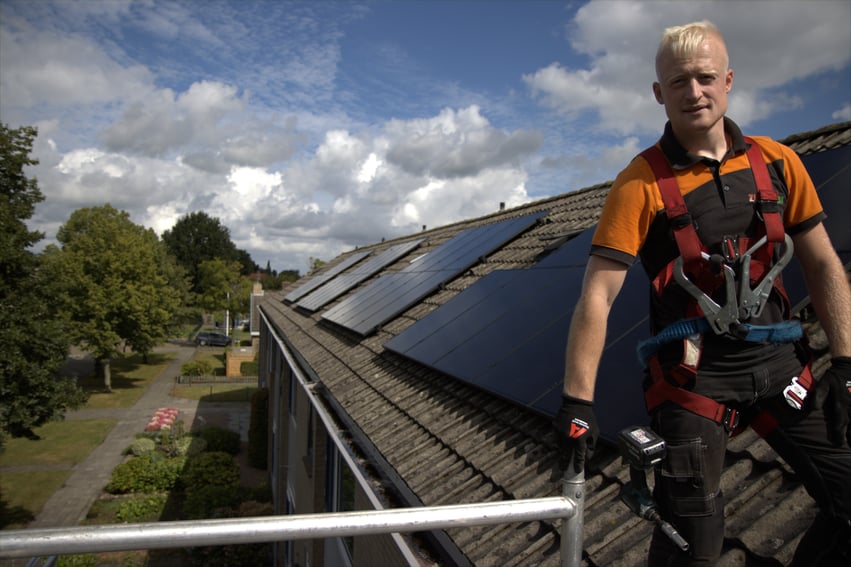The use of the correct mounting system, compliance with regulations and having the necessary guarantees is essential in solar module installations. Even during a heavy storm, the solar module owner and the installer must be able to sleep peacefully. All mounting systems of Van der Valk Solar Systems are wind tunnel tested and developed according to the necessary standards and regulations, guaranteeing a good and safe installation for a warranty period of at least 10 to a maximum of 25 years. In this blog, we explain the two most common ways to mount solar modules: on a pitched and flat roof.

Mount solar modules on a pitched roof
There are various options for mounting the solar modules on a pitched roof, namely using a screwed roof hook (Smartline / Strongline) or a hanging hook (Slimline). For example, a solution can be devised for every type of roof, whereby the necessary knowledge of the roof structure is, of course, very important.
With a hanging hook, it is always key to find out what the condition of the batten is; it is also good to check whether the batten is screwed. If the batten is nailed, it is advisable not to use a hanging hook. It is better to use a screwed hook with supplied construction wood such as the Smartline roof hook.
There are different methods for securing the actual modules onto the system. For example, it is possible to mount the solar modules using universal panel clamps (clamping range of 28-50 mm) or using an insert system that does not require panel clamps. An insert system provides a very nice sleek finish while retaining the safety of a roof system.
Mount solar modules on a flat roof
Various things come into play when mounting solar modules on a flat roof. For example, it is important to check what the location of the roof is and which set-up can achieve the best efficiency. Are you installing the modules in a South or East-West configuration? Then it is best to place the optimal number of solar modules in Portrait or Landscape orientation. Also look at what the ideal angle of inclination is in this specific case, taking into account the yield but also the required ballast.
If you want to make the best possible use of the existing roof surface, you can also place the ValkPro+ system in the corner and edge zone of the building. The use of side plates is mandatory in that case. If the solar modules are only placed in the middle zone of the roof, side plates are not necessary.
Moreover, it is essential to know what the maximum roof load is and if the mounting system is compatible with the type of insulation, whether present or not. A point load too high, can, for example, damage the roof covering and/or insulation, it is important in that case to take the necessary measures, for example by using rubber pressure distributors with the ValkPro+ system. Wind tunnel tests and linked rows make it possible to make optimum use of as little ballast as possible. If the roof is too weak to bear ballast, a ballast-free system can also be used. The flat roof system is anchored to the roof using consoles, ValkSolarFix.
Your project via Van der Valk Solar Systems
The experienced project team of Van der Valk Solar Systems can support you in calculating special cases. For example, with a higher adjacent building, or if there is a building in the area that is significantly higher. Pay attention; this affects the ballast and the use of side plates! These are all things that must be taken into account when mounting modules to a flat roof.
With our ValkPVplanner you can create the design using a standard pitch size. If the situation requires it, it is also possible to deviate from the standard pitch size, and there are various solutions to achieve a better result with an adjusted pitch size. This may be necessary, for example, for the use of as many modules as possible, but it can also provide a solution to reduce the weight per square meter.
Hopefully, this blog has given more clarity about the installation of solar modules on a pitched and flat roof and the importance of a good substructure. There is much more to tell about different situations and solutions, if you would like to discuss this further with us, you are more than welcome for a training/tour of our factory or a no-obligation conversation with one of our specialists. You can contact us via: sales@valksolarsystems.com or +31 (0)174 - 25 49 99.
Photo by: Zonmaat